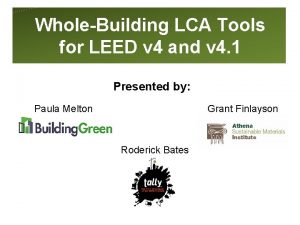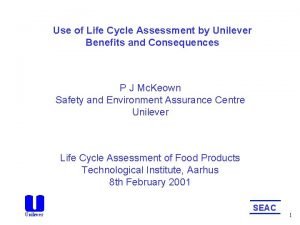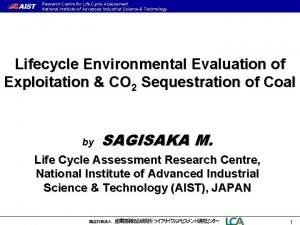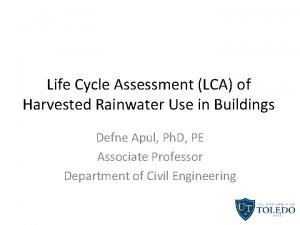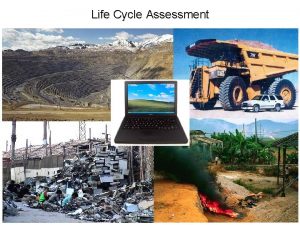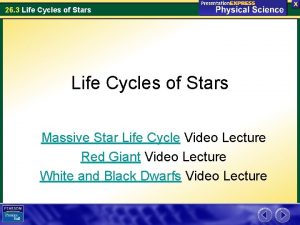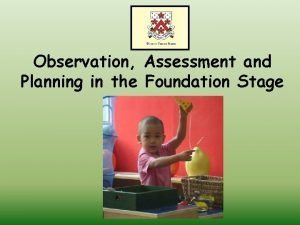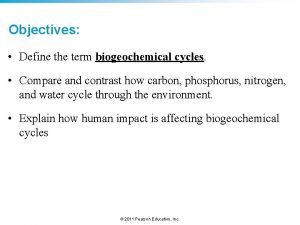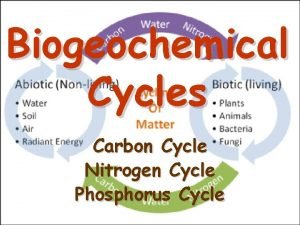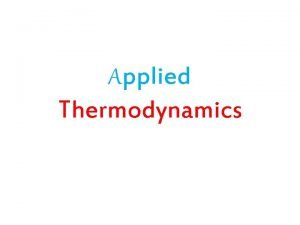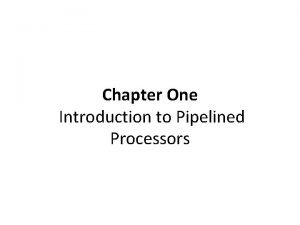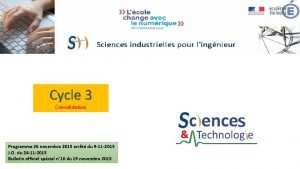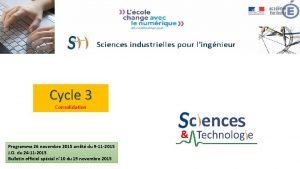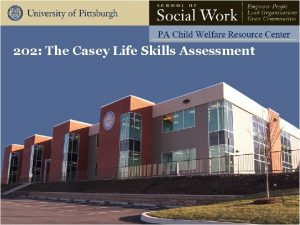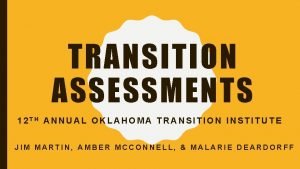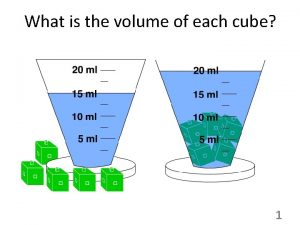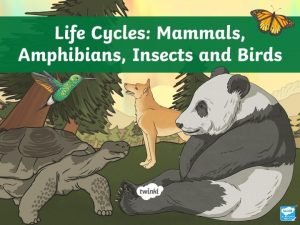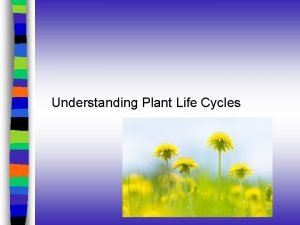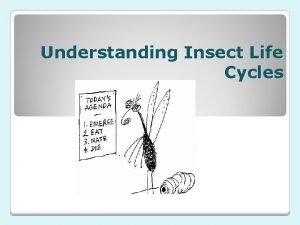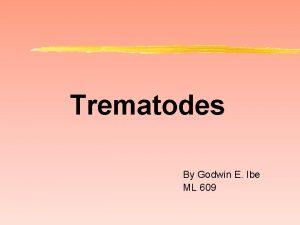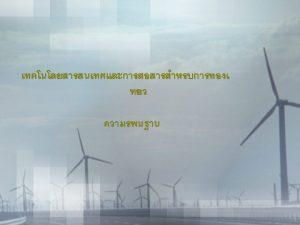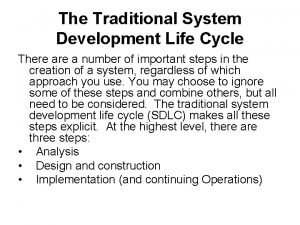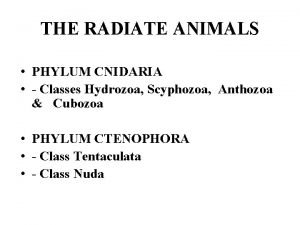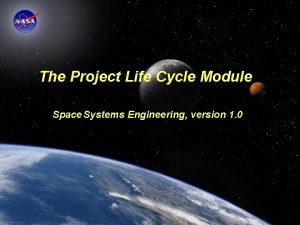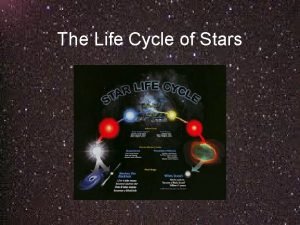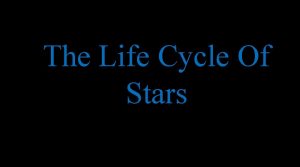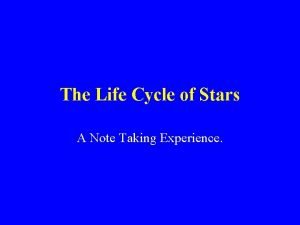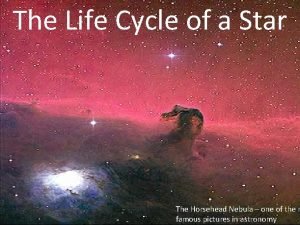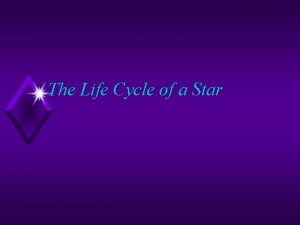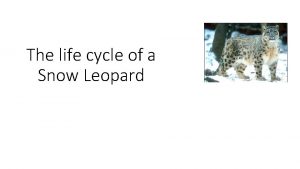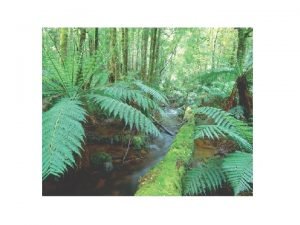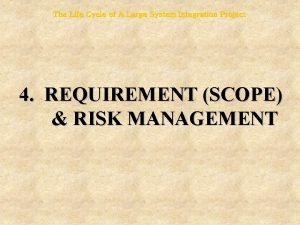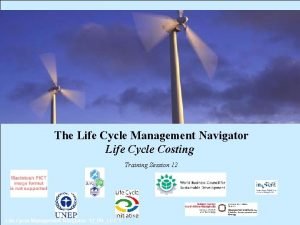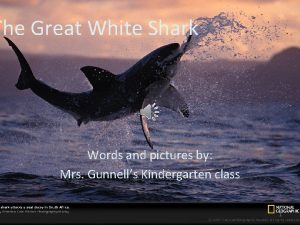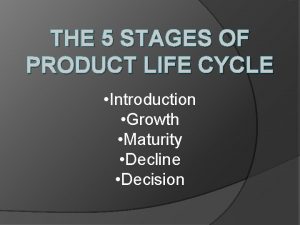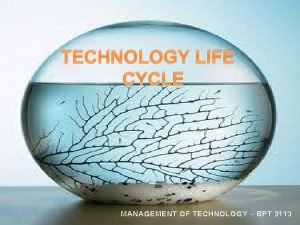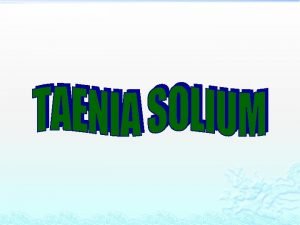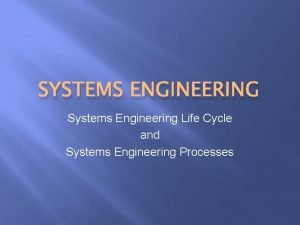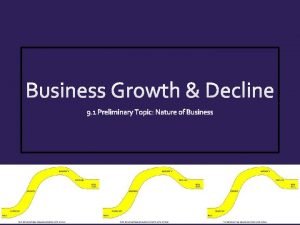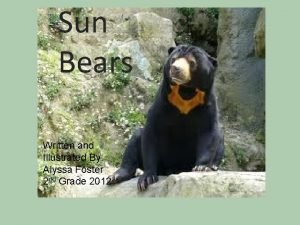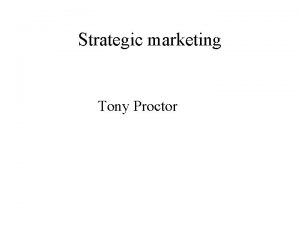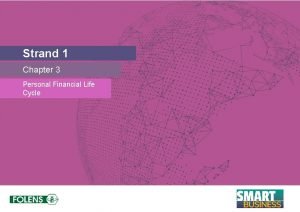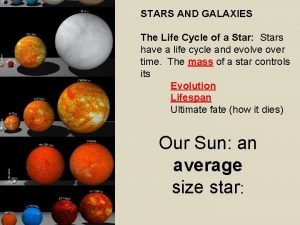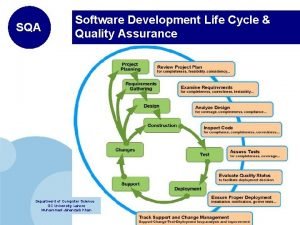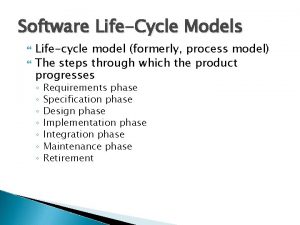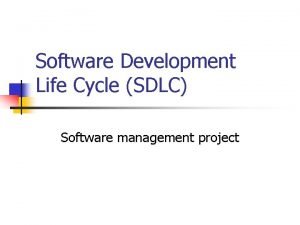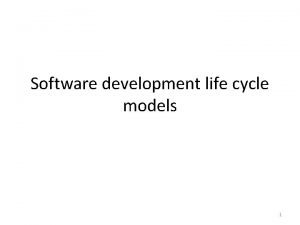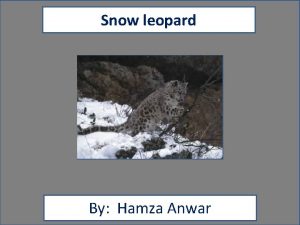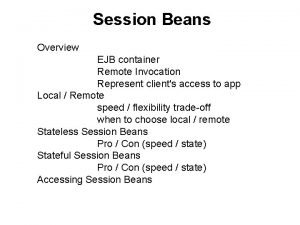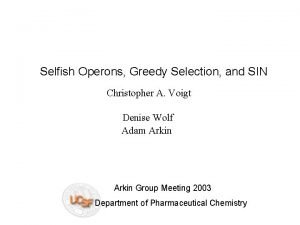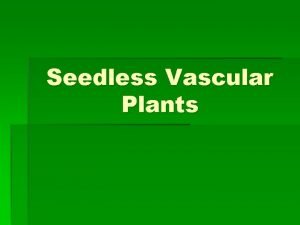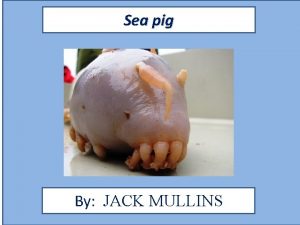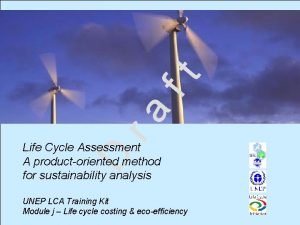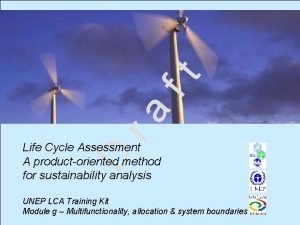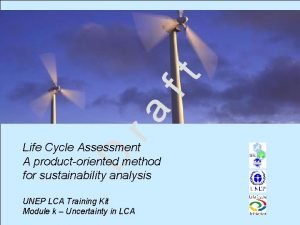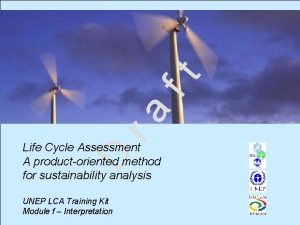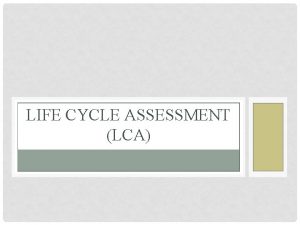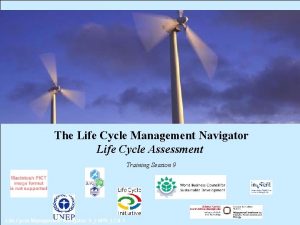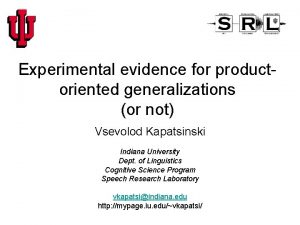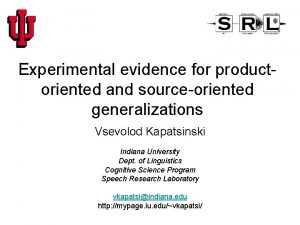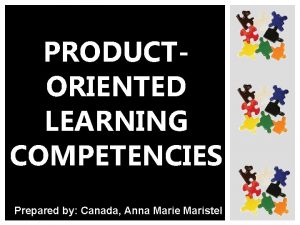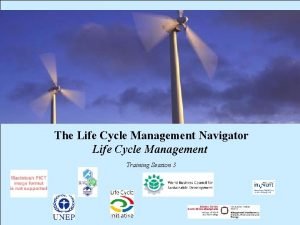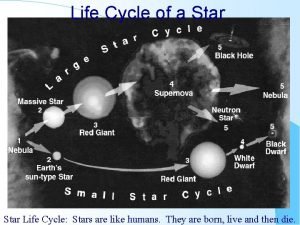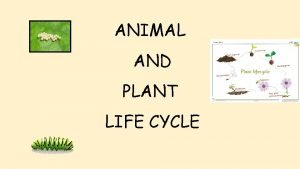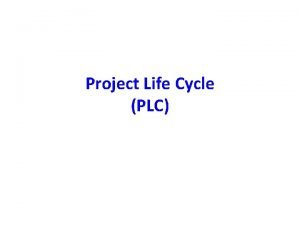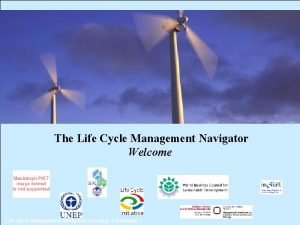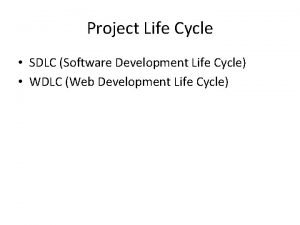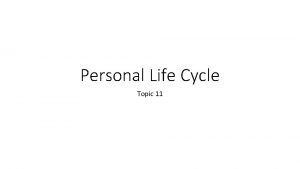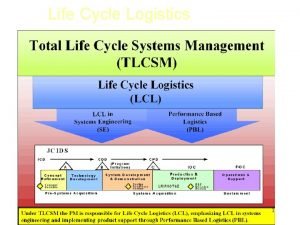ft ra D Life Cycle Assessment A productoriented













































































- Slides: 77

ft ra D Life Cycle Assessment A product-oriented method for sustainability analysis UNEP LCA Training Kit Module a –LCA and decision support 1

Content Demand for environmental information Supply of environmental information Examples of environmental information Survey of analytical tools LCA – main characteristics – main applications – main limitations and how to solve them – LCA and certification ft • D ra • • 2 2 2

Demand for environmental information (1) D ra ft • Possible objects of decision making – substance, material – product, service – waste, waste management – process, installation – activity, project, building, infrastructure – company – technology – societal sector – life style – … 3 3 3

Demand for environmental information (2) D ra ft • Types of decision situations – strategic planning and capital investments (green building, waste management) – eco-design, product development – operational management (green procurement) – communication and marketing (eco-labelling, product information) 4 4 4

Demand for environmental information (3) D ra ft • Spatial requirements – local (site specific) – regional (site dependent) – global (generic) • Temporal requirements – snapshot – steady state / comparative static – (quasi) dynamic 5 5 5

Demand for environmental information (4) D ra ft • Complex decision situations, yet simple information required – simple indicators – visualization – aggregation – weighting • Simple format for final presentation 6 6 6

Supply of environmental information (1) ft Concepts ra Decision process D Analytical tools implementation policy instruments Procedural tools Content: technical elements / basic equations / data 7 7 7

Supply of environmental information (2) D ra ft • Concepts – life cycle thinking / life cycle management (LCM) – design for environment (Df. E) – cleaner technology – green chemistry – dematerialisation – industrial ecology / industrial metabolism – end of life management – eco-efficiency (or analytical tool? ) – … 8 8 8

Supply of environmental information (3) D ra ft • Decision process, policy instruments and implementation – direct implementation of activities – legal instruments (physical regulation) – financial instruments – communication instruments (e. g. , environmental labelling (= eco-labelling) 9 9 9

Supply of environmental information (5) D ra ft • Analytical tools – physical metrics • environmental risk assessment (ERA), life cycle assessment (LCA), material flow analysis (MFA), energy analysis, ecological footprint, … – monetary metrics • cost benefit analysis (CBA), total cost analysis (TCA), life cycle costing (LCC), input-output analysis (IOA), … 10 10 10

Supply of environmental information (6) D ra ft • Procedural tools – in-company management systems • quality management systems (EHS), environmental management systems (EMAS, EMS), environmental audit, … – permits • environmental impact assessment (EIA), environmental license, … – others • green procurement, voluntary agreements between stakeholders, … 11 11 11

Supply of environmental information (7) D ra ft • Content – technical elements / basic equations • mass balance models, dispersion models, dose-effect relationships, market behavior, uncertainty analysis, multicriteria analysis, … – data • sectoral emissions, product composition, chemical persistence, LC 50, income elasticity, … 12 12 12

Supply of environmental information (8) D ra ft • Empirical information on the relations between noise levels and the presence of birds 13

Supply of environmental information (9) D ra ft • Quasi-empirical information on the relation between the concentration of a chemical and the impact on organisms 14 14 14

D ra ft Examples of environmental information (1) Source: http: //www. pg. com/content/pdf/01_about_pg/corporate_citizenship/sustainability/reports/CBR_Procter. Gamble_061. pdf 15

D ra ft Examples of environmental information (2) Source: http: //corporate. basf. com/en/sustainability/ 16

http: //www. clw. csiro. au/publications/technical 2005/tr 1 -05. pdf D ra ft Examples of environmental information (3) 17

Examples of environmental information (4) D ra ft • Ecolabeling – criteria based on life-cycle considerations – just a few examples 18

Survey of analytical tools (1) D ra ft • Tools in physical metrics – checklists and matrices – risk-based tools – tools for product and service systems – regional tools • Tools in monetary metrics 19 19 19

Survey of analytical tools - checklists Criterion 2: CO 2 emissions ra Criterion 1: critical resources ft • Checklists and matrices Alternative 2 Alternative 3 --- - --- 0 --- - 0 ++ -- D Alternative 1 Criterion 3: hazardous emissions 20 20 20

Survey of analytical tools –risk-based tools (1) D ra ft • Risk-based tools – Risk Analysis (RA) – Environmental Risk Assessment (ERA) 21 21 21

Survey of analytical tools –risk-based tools (2) D ra ft • Risk analysis – for assessing the risk of incidents and calamities – focus on human health, or broader – local, or broader – typically for large industrial installations – risk analysis vs. risk perception – risk = chance effect 22 22 22

D ra ft Survey of analytical tools –risk-based tools (3) 23

Survey of analytical tools –risk-based tools (4) D ra ft • Environmental risk assessment (ERA) – for assessing the risk of regular emissions – focus on emission of and exposure to toxic substances – focus on risk to ecosystems but also for human health (HERA) – risk characterisation ratio: PEC/PNEC 24 24 24

D ra ft Survey of analytical tools –risk-based tools (5) 25

D ra ft Survey of analytical tools –risk-based tools (6) 26

Survey of analytical tools –risk-based tools (7) D ra ft • Use of (H)ERA – admission of chemicals – prioritizing substance policy • Non-use of (H)ERA – drinking water quality – food quality 27 27 27

Survey of analytical tools – tools for product and service systems (1) D ra ft • Tools for product and service systems – Life Cycle Assessment (LCA) – Total Material Requirement (TMR), Material Input per Unit of Service (MIPS) – Energy analysis/cumulative energy demand (CED) 28 28 28

Survey of analytical tools – tools for product and service systems (2) D ra ft • Life cycle assessment (LCA) – focus on comparison of products with similar functions – from the cradle to the grave – covering a wide range of environmental aspects • impacts on human health (climate change, ozone depletion, smog, toxicity, etc. ) • impacts on ecosystem quality (acidification, eutrophication, toxicity, etc. ) • impacts on resource availability (depletion of minerals, fossil fuels, etc. ) 29 29 29

ft Survey of analytical tools – tools for product and service systems (3) D ra Source: http: //www. fibersource. com/f-tutor/LCA-Page. htm 30

Survey of analytical tools – tools for product and service systems (4) D ra ft • Total Material Requirement (TMR), Material Input / Unit of Service (MIPS) – focus on mass-flow input only (total mass input per functional unit) – including “rucksacks” – what is the “weight” of a golden ring? – focus on global, steady state 31 31 31

Survey of analytical tools – tools for product and service systems (5) D ra ft • Energy analysis/cumulative energy demand (CED) – focuses on (fossil) energy input – also objective to produce encompassing indicator for total environmental burden – objects can be product systems or regions ( regional tool) – focus on global, steady state – used for, e. g. , support of climate policy or resource strategy 32 32 32

Survey of analytical tools – regional tools (1) D ra ft • Regional tools – Material Flow Analysis (MFA) • for economy of a region, without rucksacks • for economy of a region, with rucksacks (cf. MIPS) – Substance Flow Analysis (SFA) • for region, with economy and environment as subsystems – Ecological Footprint (EF) 33 33 33

Survey of analytical tools – regional tools (2) D ra ft • Material Flow Analysis (MFA) – material balance for economy of a region (in kg) (or country) • focus: for a given year – if with rucksacks, then functional approach ( MIPS) – for economy: in = out + accumulation – potential relevance at regional level as indicator for dematerialisation – typical applications: • comparisons between countries or large economic sectors • changes over time for countries or sectors 34 34 34

D • Basic template – TMR = total material requirement – DMI = domestic material input ra ft Survey of analytical tools – regional tools (3) 35

Survey of analytical tools – regional tools (5) D ra ft • Substance Flow Analysis (SFA) – Flows of single substances through economy and potentially environment of a region • typical examples: N, P, heavy metals (Cd, Hg, Pt, In, others) • focus on regions of any size • focus on results for a given year – Typical results: • origin analysis of problem flows to environment • risks of unnoticed accumulations in economy • potentials of urban mining • risks of unintended inflows – Typical application: • for support of substance policies 36 36 36

Draft Survey of analytical tools – regional tools (6) 37

Survey of analytical tools – tools for product and service systems (5) D ra ft • Ecological footprint – aim: to express the total environmental pressure in terms of space consumption (in hectare or square meters) – for hazardous substances: dilution up to thresholds – for energy: biomass production – focus on global, steady state • Status: – large policy support, but scientifically debated 38 38 38

Survey of analytical tools – tools in monetary metrics (1) D ra ft • Cost-Benefit Analysis (CBA) • Input-Output Analysis (IOA) • Life Cycle Costing (LCC)/Total Cost Accounting (TCA) 39 39 39

Survey of analytical tools – tools in monetary metrics (2) D ra ft • Cost-benefit analysis (CBA) – for a single activity – all impacts expressed in monetary terms (using several methods, particularly Wt. P) – high policy profile, many applications – severely criticised by environmental scientists because of under-representation of ecological damage – focus: local, steady state • Typical application: support of decisions on governmental investment activities (e. g. , infrastructure, waste management) 40 40 40

Survey of analytical tools – tools in monetary metrics (3) D ra ft • Input-output analysis (IOA) – established tool (Leontief, 1930 -ies, Nobel prize 1973) – monetary flows between economic sectors – what are consequences of specific investment (policy change) in one specific sector? – focus: national level, given year • Environmental IOA (EIOA) – environmental extensions (“satellites”) • Typical application: prioritization regarding policy support of different economic sectors 41 41 41

Survey of analytical tools – tools in monetary metrics (4) D ra ft • Life cycle costing (LCC)/Total cost accounting (TCA) – LCA in monetary terms (same structure; global level, steady state) – aims to quantify hidden costs over the life cycle (risk management, waste management, communication, illnesses, etc. ) – can have two forms: • including (monetised) environmental impacts • excluding environmental impacts • Typical application: to be used in conjunction with LCA – or even integrated with LCA in eco-efficiency 42 42 42

Life Cycle Assessment (1) D ra ft • Life cycle assessment (LCA) – product from cradle to grave (vertical integration) • total picture; avoidance of problem shifting – all types of impact (horizontal integration) – role of functional unit • for comparability of different product systems – integration over space and time – standardised in ISO (14040 series) 43 43 43

D ra f. D t ra ft Life Cycle Assessment (2) Source: ISO 14040 44 44 44

Life Cycle Assessment (3) D ra ft • Final result can be in terms of: – LCI results (extractions and emissions) – LCIA results (for separate impact categories) – weighted results (one index) • Weighting (subjective!) possible on basis of: – distance to target (policy reference) – economic values (various possibilities, incl. collectively revealed preferences) – social preferences (panel process) 45 45 45

Life Cycle Assessment (4) Draft ft • Example of the results of a comparative LCA Incandescent lamp Fluorescent lamp Climate change 120000 kg CO 2 -eq 40000 kg CO 2 -eq 320 kg DCB-eq 440 kg DCB-eq 45 kg SO 2 -eq 21 kg SO 2 -eq Depletion of resources 0. 8 kg antinomy-eq 0. 3 kg antinomy-eq etc … … ra Impact category Acidification D Ecotoxicity 46 46 46

Life Cycle Assessment (5) D ra ft • Main applications – product comparisons – product improvement, design and development – strategy and policy development – LCA as a process 47 47 47

Life Cycle Assessment – main applications (1) D ra ft • Product comparisons – by industry, government, NGOs – also for ecolabeling (type I, type III) • Note: – need for authorized procedure and peer review – “comparative assertions disclosed to the public” (ISO) 48 48 48

D ra ft Life Cycle Assessment – main applications (2) Draft 49 49 49

Life Cycle Assessment – main applications (3) D ra ft • Product improvement, design and development – by industry – also on the basis of adapted LCA-tools • Learning curve: – LCA suggests rules of thumb – rules of thumb further validated and improved by LCA 50 50 50

D ra ra ft ft Life Cycle Assessment – main applications (4) 51 51 51

ft ra D D ra ft Life Cycle Assessment – main applications (5) 52 52 52

Life Cycle Assessment – main applications (6) D ra ft • Policy and policy development – by government, sometimes together with industries or NGOs – examples: • waste management • packaging • EU's Integrated Product Policy (IPP) • energy policy • green building 53 53 53

D Dr r aa ff t t Life Cycle Assessment – main applications (7) 54 54 54

D D r ra af ft t Life Cycle Assessment – main applications (7) 55 55 55

Life Cycle Assessment – main applications (8) D ra ft • LCA as a process – LCA as a vehicle of discussion for various stakeholders • producer • supply chain • competitors • purchasers • government • NGOs 56 56 56

Life Cycle Assessment – main limitations (1) D ra ft • LCA in practice obstructed by: – data requirements – methodological inconsistencies – technical characteristics 57 57 57

Life Cycle Assessment – main limitations (2) D ra ft • Data requirements – only general, no specific data – obsolete data – only data from industrialized countries – different data formats – databases not connected • Role for ISO 14048 and UNEP/SETAC Life Cycle Initiative • Role for input-output analysis (and hybrids of IOA and LCA) 58 58 58

Life Cycle Assessment – main limitations (3) D ra ft • Methodological inconsistencies and debates: – main issues in LCI: • system boundaries • multiple processes/allocation • attribution versus change oriented – main issues in LCIA • midpoint versus damage level • heterogeneous mechanisms (e. g. , toxicity) • regionalisation 59 59 59

Life Cycle Assessment – technical characteristics (1) D ra ft • Some specific details: – global/regional, not local – steady state, not dynamic, no one-time transitions – quantitative, not pass/fail criteria – risk approach, not prevention approach 60 60 60

Life Cycle Assessment – technical characteristics (2) D ra ft • Usual impact categories: – depletion of fossil fuels and minerals – climate change – ozone depletion – photo-oxidant formation – acidification – eutrophication – human toxicity and ecotoxicity 61 61 61

Life Cycle Assessment – technical characteristics (3) D ra ft • Potential impact categories: – land occupation (area) – water use – salination – soil erosion – leakage of nutrients – noise 62 62 62

Life Cycle Assessment – technical characteristics (4) D ra ft • Not fitting impact categories: – land use quality (forest, coral reefs) – depletion of wildlife and fish stocks – desiccation; desertification – biodiversity – contained toxics 63 63 63

Life Cycle Assessment – technical characteristics (5) D ra ft • Need to make LCA – broader (more impacts, also covering economic and social aspects) – deeper (more precise, more mechanisms) • How to make LCA broader and deeper – three major options: • extension of LCA • hybrid LCA • use of toolbox (with additional quantitative tools, or using pass-fail criteria) 64 64 64

Pass-fail criteria – black lists D ra ft • Some examples: – substances contained in products (lead in pencils; Cl in PVC; plastic weakeners in toys) – substances contained in manufacturing processes (phosgene for PET production, isocyanate for polyurethane production) 65 65 65

Pass-fail criteria – certification D ra ft • Used for companies (ISO 14001) • Also for natural resources: – use of criteria – can be included in life cycle approach • Many examples: – forestry – fishery – agriculture – mining 66 66 66

Certification - sustainable forestry (1) D ra ft • The problems: – net loss 1980 -1995: 12 mln ha / year – decline in developing world, increase in industrialised world – drivers: timber and land for agriculture 67 67 67

Certification - sustainable forestry (2) D ra ft • Two types of certification: – forestry management – chain of custody • Forest Stewardship Council (FSC) – 1993, others followed – now 6 global organisations with 3 rd party review • Effective through large companies (lumber retailers, manufacturers, retailers), not through individual consumers • Reasons: good image and sustainable business, not large financial interest 68 68 68

D Dr r aa ff t t Certification - sustainable forestry (3) 69 69 69

Certification - sustainable forestry (4) D ra ft • Requirements for certificate – existence of management plan – restoration of natural forest – diversity in tree species and age classes – preference for native species – part of plantation managed as natural forest – soil and water conservation – integrated pest management – monitoring of ecological and social impacts – no change of natural forest after 1994 70 70 70

Certification - sustainable fishery (1) D ra ft • The problems: – fish provides 40% of protein in developing countries – fishing down the food chain; peak in 1989 – tragedy of the commons – improving technology, larger distances – by-catch (30 -70%), thrown over board – damage to marine habitats (coral reefs, sea mounts) 71 71 71

Certification - sustainable fishery (2) D ra ft • Marine Stewardship Council (MSC) – initiative Unilever and WWF, 1997 • Criteria setting by fishermen, fisheries managers, seafood processors, retailers, scientists and NGOs • Certificates deal with fish stocks and fishing methods • Role of fishermen collectives • Life cycle perspective: chain of custody certification • Next step: also certification of aquaculture? 72 72 72

Certification - sustainable fishery (3) D ra ft • Criteria: – healthy fish stock – sustainable harvest – ecosystem integrity – minimisation of by-catch – clear rules and procedures – compliance with existing laws 73 73 73

Certification - sustainable agriculture (1) D ra ft • Organic versus current agriculture – since 1927 • Limitations regarding space requirements • Better perspectives for integrated or sustainable agriculture – minimisation use of pesticides – wise use of fertilizers – enhancement of biodiversity • Since 2002 Sustainable Agriculture Initiative – global platform of companies in food chain, started by Unilever, Nestlé and Danone 74 74 74

Certification - sustainable mining (1) D ra ft • The problems: – huge environmental impacts of extraction of fossil fuels and minerals • Not yet certificates more sustainable performing companies – for fossil fuels: Chevron, BP, Shell – for minerals: Rio Tinto • In progress: sustainable mining project of ICMM 75 75 75

Certification and LCA D ra ft • Double relationship to LCA – LCA and certification completely different worlds – but mutual support is advisable: • LCA can support certification for “its own” impact categories (climate change, etc. ) • certification can provide information for new LCA impact category: amount of (non-) certified resources per functional unit 76 76 76

Conclusions D ra ft • LCA well developed, high profile tool – developments mainly at harmonization – broad spectrum of applications • Also number of clear limitations, no “super tool” – strong need for additional tools, also in life cycle context • Mutual support advisable between LCA and certification 77 77 77
 Whole building life cycle assessment wblca
Whole building life cycle assessment wblca Unilever benefits
Unilever benefits Life cycle assessment
Life cycle assessment Life cycle assessment of rainwater harvesting
Life cycle assessment of rainwater harvesting Life cycle assessment
Life cycle assessment Life cycle of a star assessment
Life cycle of a star assessment Porfolio assessment
Porfolio assessment Define dynamic assessment
Define dynamic assessment Portfolio assessment matches assessment to teaching
Portfolio assessment matches assessment to teaching Common core formative assessments
Common core formative assessments Short cycle or equivalent
Short cycle or equivalent Observation, assessment and planning cycle
Observation, assessment and planning cycle Water cycle brain pop
Water cycle brain pop Quizlet
Quizlet Difference between phosphorus cycle and carbon cycle
Difference between phosphorus cycle and carbon cycle Difference between open cycle and closed cycle gas turbine
Difference between open cycle and closed cycle gas turbine Reservation table in computer architecture
Reservation table in computer architecture Chapter 5 principles of engine operation
Chapter 5 principles of engine operation Compétence attendue handball cycle 4
Compétence attendue handball cycle 4 Mhd power generation ppt
Mhd power generation ppt Cycle de consolidation
Cycle de consolidation Cycle 3 cycle de consolidation
Cycle 3 cycle de consolidation Water cycle the hydrologic cycle
Water cycle the hydrologic cycle Casey life skills curriculum
Casey life skills curriculum Casey life skills assessment scoring
Casey life skills assessment scoring Eternal samsara
Eternal samsara Wolverine life cycle stages
Wolverine life cycle stages Life cycle of blowfly
Life cycle of blowfly Which island is the oldest
Which island is the oldest Distribution life cycle
Distribution life cycle Similarities between mammals and amphibians
Similarities between mammals and amphibians Annuals plant life cycle
Annuals plant life cycle Insect life cycle stages
Insect life cycle stages Trematode life cycle
Trematode life cycle Travel life cycle
Travel life cycle Thomson gazelle facts
Thomson gazelle facts Life cycle of ant
Life cycle of ant Traditional life cycle
Traditional life cycle Phylum cnidaria unique characteristics
Phylum cnidaria unique characteristics Systems engineering life cycle phases
Systems engineering life cycle phases Wolf life cycle facts
Wolf life cycle facts Stages of painted lady chrysalis
Stages of painted lady chrysalis Life cycle of a star
Life cycle of a star The life cycle of a small star
The life cycle of a small star Life cycle of stars
Life cycle of stars Life cycle of snail
Life cycle of snail Life cycle of a star
Life cycle of a star Star life cycle
Star life cycle Newborn snow leopard
Newborn snow leopard Hepatophyta life cycle
Hepatophyta life cycle System integration lifecycle
System integration lifecycle Life cycle costing
Life cycle costing Shark glossary
Shark glossary Cycle alliteration
Cycle alliteration Black panther life cycle images
Black panther life cycle images 5 stages of product life cycle
5 stages of product life cycle Technology life cycle
Technology life cycle Cysticercus cellulosae
Cysticercus cellulosae Systems engineering lifecycle
Systems engineering lifecycle Business life cycle
Business life cycle Sun bear reproduction
Sun bear reproduction Family life cycle marketing
Family life cycle marketing Stages of financial life cycle
Stages of financial life cycle Life cycle of galaxies
Life cycle of galaxies Sqa software development
Sqa software development Spider monkeys life cycle
Spider monkeys life cycle Object oriented life cycle model
Object oriented life cycle model Software
Software Rad model in software engineering
Rad model in software engineering Life cycle of a snow leopard
Life cycle of a snow leopard New product development and product life cycle strategies
New product development and product life cycle strategies Karirlama
Karirlama Life cycle of a tiger with labels
Life cycle of a tiger with labels Stateful session bean life cycle
Stateful session bean life cycle Life cycle of polyporus
Life cycle of polyporus Salmonella life cycle
Salmonella life cycle Life cycle of seedless plants
Life cycle of seedless plants Sea pig picture
Sea pig picture
